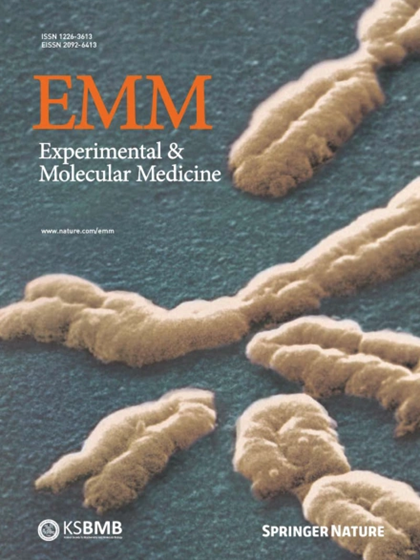YTHDC1 m6A阅读功能的丧失促进膀胱尿路上皮癌的侵袭性。
IF 9.5
2区 医学
Q1 BIOCHEMISTRY & MOLECULAR BIOLOGY
引用次数: 0
摘要
膀胱癌由于其高转移性和预后差,特别是当其进展到肌肉侵袭期时,给临床带来了重大挑战。在这里,我们发现m6A读取器YTHDC1在肌肉侵袭性膀胱癌中下调,并且与上皮-间质转化基因的表达呈负相关。YTHDC1的功能抑制或缺失增加了尿路上皮细胞的迁移和侵袭。多模态测序数据集的综合分析提供了介导ythdc1依赖表型的分子机制的详细见解,并确定SMAD6是参与膀胱尿路上皮癌侵袭性的关键转录物。值得注意的是,SMAD6 mRNA在肿瘤组织中与YTHDC1的共定位少于肿瘤旁组织,表明在癌症进展过程中结合被破坏。我们的研究结果确立了ythdc1依赖性m6A读取是调控膀胱癌侵袭性的关键外转录组机制,并为癌症相关网络的外转录组调控提供了范例。本文章由计算机程序翻译,如有差异,请以英文原文为准。

Loss of YTHDC1 m6A reading function promotes invasiveness in urothelial carcinoma of the bladder
Bladder cancer poses significant clinical challenges due to its high metastatic potential and poor prognosis, especially when it progresses to muscle-invasive stages. Here, we show that the m6A reader YTHDC1 is downregulated in muscle-invasive bladder cancer and is negatively correlated with the expression of epithelial‒mesenchymal transition genes. The functional inhibition or depletion of YTHDC1 increased the migration and invasion of urothelial cells. Integrative analysis of multimodal sequencing datasets provided detailed insights into the molecular mechanisms mediating YTHDC1-dependent phenotypes and identified SMAD6 as a key transcript involved in the invasiveness of urothelial carcinoma of the bladder. Notably, SMAD6 mRNA colocalized less with YTHDC1 in tumoral tissues than in paratumoral tissues, indicating disrupted binding during cancer progression. Our findings establish YTHDC1-dependent m6A reading as a critical epitranscriptomic mechanism regulating bladder cancer invasiveness and provide a paradigm for the epitranscriptomic deregulation of cancer-associated networks. Bladder cancer is a common and potentially deadly disease affecting the urinary system. Researchers have identified a protein called YTHDC1, which reads specific RNA modifications (chemical changes to RNA that affect its function), as being less present in more aggressive cases of bladder cancer. This study investigates how YTHDC1 influences the invasiveness of cancer cells. The research involved analyzing bladder cancer samples and conducting experiments on cell models, using RNA sequencing (a method to study the sequence of RNA) and other techniques to understand YTHDC1’s role in cancer progression. Results indicated that lower levels of YTHDC1 are associated with increased cancer cell invasion and migration. The study concludes that YTHDC1 is crucial in preventing cancer spread by regulating specific genes. Future research could explore YTHDC1 as a potential target for bladder cancer treatment. This summary was initially drafted using artificial intelligence, then revised and fact-checked by the author.
求助全文
通过发布文献求助,成功后即可免费获取论文全文。
去求助
来源期刊

Experimental and Molecular Medicine
医学-生化与分子生物学
CiteScore
19.50
自引率
0.80%
发文量
166
审稿时长
3 months
期刊介绍:
Experimental & Molecular Medicine (EMM) stands as Korea's pioneering biochemistry journal, established in 1964 and rejuvenated in 1996 as an Open Access, fully peer-reviewed international journal. Dedicated to advancing translational research and showcasing recent breakthroughs in the biomedical realm, EMM invites submissions encompassing genetic, molecular, and cellular studies of human physiology and diseases. Emphasizing the correlation between experimental and translational research and enhanced clinical benefits, the journal actively encourages contributions employing specific molecular tools. Welcoming studies that bridge basic discoveries with clinical relevance, alongside articles demonstrating clear in vivo significance and novelty, Experimental & Molecular Medicine proudly serves as an open-access, online-only repository of cutting-edge medical research.
 求助内容:
求助内容: 应助结果提醒方式:
应助结果提醒方式:


